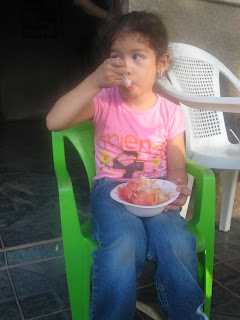One of the things I love about Nicaragua is that there are all kinds of treats you can buy super cheap as a snack. People prepare them and walk around the streets shouting out what they have on a daily basis. A lot of the women balance large plastic buckets full of their goods on their heads, and I’m always amazed that they don’t drop everything since it’s balanced there on a rolled up towel and not strapped down or anything!
A lot of the treats you can get are cold, which is definitely a welcome break from the heat.
One of the most popular is called “raspado”, and is shaved ice with flavoring on it – most often either dulce de leche or a fruity flavor. The raspado vendor has a brightly painted cart with huge hunks of ice inside, a scraper, and the flavorings in glass bottles on the top of the cart. They push the cart around ringing a bell, and at certain times of the day, people flock around the cart for their treat. Here are some pictures of my most recent raspado experience:
Step 1: Scraping the ice with a special tool that collects it so he can put it in a bowl.
Step 2: Pouring on flavoring. This one already has dulce de lecha, and he's adding a fruit flavoring - "combinado" because it has two flavors
Gabriela enjoying her raspado, or as she says, "zaspado" because she can't quite pronounce the rolled r yet!Another cold, refreshing treat is called posicle and is pretty much ice cream in a bag. A lot of drinks and little treats here come in plastic bags, and to eat it, you bite of the corner and drink or suck your treat through the hole. I’ve only had posicle once, but it was absolutely delicious and so refreshing! The one we had was chocolate flavored, and I actually don’t know if it comes in other flavors...I will have to investigate that! The one downside to having the ice cream in a bag is that your hand pretty much freezes off as you are eating, and you have to juggle your treat back and forth as each hand thaws enough to endure a bit more freezing. It’s SO worth it.
Fresco is probably the most popular cool drink (other than Coca Cola…), and it’s so refreshing (I feel like a broken record, but it’s so true!). Fresco is a fruit drink that is made of various types of fruit, depending on what’s in season. I've had pineapple juice, orange and carrot (that combination is super popular), watermelon with other fruits, and a mixture of a bunch of different fruits. To make it, they squeeze out the fruit juice, add some sugar and water, and you’ve got your drink! Doña Matilde (the mother of the family I’m staying with) makes me fresco every morning for breakfast, and I often have it for lunch as well. She blends the fruit, but it’s still just like drinking a glass of juice, only much fresher.
Finally, there is a treat I have yet to try called quesillo. The women who sell it carry the ingredients in a plastic tub on their head and walk around shouting "quesillooooooooooo" with an extra elongated "o" on the end. Quesillo is kind of like a burrito - they take a corn tortilla and put a hunk of quesillo in it (a type of cheese), then add sour cream and pickled onions and put the whole thing into a plastic bag (since it would otherwise leak out everywhere and cause a huge mess). As with the posicle, you then bite a hole into one corner and eat it through the hole.
So, there you have a few Nicaraguan specialties! I'm sure I will discover more and will share them with you!
















